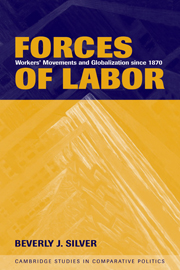Book contents
- Frontmatter
- Contents
- List of Figures
- List of Tables
- Preface and Acknowledgments
- 1 INTRODUCTION
- 2 LABOR MOVEMENTS AND CAPITAL MOBILITY
- 3 LABOR MOVEMENTS AND PRODUCT CYCLES
- 4 LABOR MOVEMENTS AND WORLD POLITICS
- 5 CONTEMPORARY DYNAMICS IN WORLD-HISTORICAL PERSPECTIVE
- Appendix A The World Labor Group Database: Conceptualization, Measurement, and Data Collection Procedures
- Appendix B Instructions for Recording Data from Indexes
- Appendix C Country Classifications
- References
- Index
- Cambridge Studies in Comparative Politics
3 - LABOR MOVEMENTS AND PRODUCT CYCLES
Published online by Cambridge University Press: 05 June 2012
- Frontmatter
- Contents
- List of Figures
- List of Tables
- Preface and Acknowledgments
- 1 INTRODUCTION
- 2 LABOR MOVEMENTS AND CAPITAL MOBILITY
- 3 LABOR MOVEMENTS AND PRODUCT CYCLES
- 4 LABOR MOVEMENTS AND WORLD POLITICS
- 5 CONTEMPORARY DYNAMICS IN WORLD-HISTORICAL PERSPECTIVE
- Appendix A The World Labor Group Database: Conceptualization, Measurement, and Data Collection Procedures
- Appendix B Instructions for Recording Data from Indexes
- Appendix C Country Classifications
- References
- Index
- Cambridge Studies in Comparative Politics
Summary
In the previous chapter our analysis of world labor unrest focused on the leading capitalist industry of the twentieth century. We followed the rise, globalization, and transformation of the mass production automobile industry. We found a cyclical pattern of labor militancy and capital relocation – a kind of déjà u pattern in which strong labor movements emerged in each new favored low-wage site to which the industry relocated. In other words, spatial fixes re-created similar working classes and class conflict wherever capital went.
In this chapter, we widen the temporal scope of the analysis. On the one hand, we move back in time in order to compare the dynamic of the automobile industry with that of the leading industry of the nineteenth century – the textile industry. On the other hand, we move forward in time in an effort to identify the leading industries of the twenty-first century and to compare their likely dynamics with those of the past.
Two arguments are central to this chapter. The first is that the main location of working-class formation and protest shifts within any single industry along with shifts in the geographical location of production. In other words, we argue that a similar déjà u pattern to that which we found for the world automobile industry can be observed also in the world textile industry. Moreover, we argue that, just as labor unrest shifts from location to location within any given industry, so the main sites of working-class formation and protest shift from industry to industry together with the rise/decline of leading sectors of capitalist development.
- Type
- Chapter
- Information
- Forces of LaborWorkers' Movements and Globalization Since 1870, pp. 75 - 123Publisher: Cambridge University PressPrint publication year: 2003



